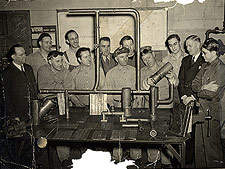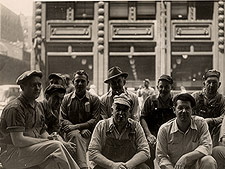
Local 562 has grown to include 4500 members who serve the plumbing and mechanical industry in 67 counties in Eastern Missouri. Our membership offers a wide array of plumbing and mechanical skills that are valued throughout the construction industry, and work daily through the employment of our signatory contractors to provide consumers and the public with the safest, most highly trained, productive workforce in the region.
The membership of Local #562 is composed primarily of plumbers and pipefitters. However, we also represent other bargaining groups such as coil cleaners, petroleum maintenance workers, lawn irrigation specialists, drain cleaners, and building maintenance workers. Each and every member of Local #562 is provided superior training and endeavors to work to the highest standard of craftsmanship. You will find on this site, a complete list of mechanical contractors and plumbing contractors that employ Local #562 members, as well as, individual lists segregating the contractors into job specific categories.
The work that is done by plumbers and pipefitters is often taken for granted. The plumber, quite literally, protects the health of the nation through the installation and maintenance of sanitary systems and appurtenances that every one of us uses everyday. The pipefitter installs all piping systems and equipment that provide our nation with the necessities of the comfortable lifestyle to which we have all become accustomed.
A Local #562 member also realizes the importance of activities outside the workplace. Samuel Gompers, a key figure in the early American Labor Movement, encouraged union members to participate in politics and to vote with their economic interests in mind. In addition, he advocated the importance of the education of union members, and that they should contribute an earnest effort to making the lives of members worth living through public and community involvement. More than one hundred years later, the members of Local #562 understand that the principles and ideology put forth by the founding fathers of the American Labor Movement are still relevant in today’s society. Some of the charitable, political, and community based activities of our Local are highlighted on other pages of this site.
A complete history of Plumbers & Pipefitters Local Union 562 is currently being compiled. It will trace the current organization back through the years to the beginnings of the U.S. labor movement in the late 1800s.


The United Association of Journeymen and Apprentices of the Plumbing and Pipe Fitting Industry of the United States and Canada, the parent Union of Sprinkler Fitters Local 550 in Boston, has a long and proud history that goes back more than 100 years.
Before and during the Civil War, plumbers and pipefitters were organized in many major cities of the United States. The first strong, long-lasting local Unions were established in the boom construction decade, 1879-1889, when United States population growth accelerated.
Journeymen in the pipe trades in the 1880s worked in three basic crafts: plumbers, steamfitters and gasfitters.
The first truly successful national body, the United Association of Journeymen Plumbers, Gas Fitters, Steam Fitters, and Steam Fitters’ Helpers of the United States and Canada, was officially founded on October 11, 1889.
Gradually, former members of rival Unions joined the United Association. The depression of 1893-1897 slowed the development of a stronger organization. Membership in the United Association grew to 6,700 in 1893, but fell to 4,400 by 1897. Yet, by that year 151 local Unions were listed on its rolls.
Starting in 1898, the construction industry entered a period of expansion and prosperity that lasted until 1914. From 1898 to 1906 the United Association quadrupled its membership.
During its first years, the United Association was essentially a federation of local Unions, rather than a truly national Union of the pipe trades. The major breakthrough toward a unified national organization came at the 1902 national convention in Omaha, when delegates approved a Nationalization Committee proposal establishing a comprehensive system of sick, death and strike benefits.
As such reforms to strengthen the national organization were being made in the early part of the century, however, some locals broke ranks to form a rival Union. In August 1906, members of the secessionist Union realized the futility of further rivalry and agreed to affiliate with the United Association.
From 1898 to 1914, the United Association went through several phases of a struggle with the International Association of Steam and Hot Water Fitters and Helpers, a prolonged and sometimes bitter dispute both over jurisdiction over a craft (steamfitting) and work assignments (plumbers vs. steamfitters). The conflict affected other building trades when walkouts by the rival steamfitting organizations, as a result of their jurisdictional dispute, led to work stoppages by other crafts.
The strength of the United Association, and favorable rulings by the American Federation of Labor, including the revocation of the International Association’s charter in 1912, ended this jurisdictional battle, but other jurisdictional issues would continue to challenge the Union.
New disputes arose over the construction of chemical plants and other manufacturing and service establishments that required extensive piping systems. Large volumes of newer types of pipefitting installation in the shift from World War I wartime industries to peacetime construction caused considerable difficulties. Jurisdictional problems also developed with other national Unions, but the United Association retained jurisdiction over important, growing areas of work like construction of industrial plants, public utilities, petroleum facilities and residential buildings.
In the first half of the century, the United Association moved to formalize apprenticeship training programs, including making a five-year apprenticeship mandatory in 1921, and in 1938 holding that all apprentices be members of the United Association and attend related training classes. Its National Plumbing Apprenticeship Plan of 1936 was the first set of standards governing apprenticeship to win approval of the federal government.
In the Depression, United Association membership fell from its 1929 peak of 60,000 to 26,000 by 1933.
After several constitutional changes through the years, the 1946 convention changed the name of the organization to its present name: The United Association of Journeymen and Apprentices of the Plumbing and Pipe Fitting Industry of the United States and Canada.
Throughout World War II and after, the United Association made considerable gains in membership and prestige. Between 1940 and 1954 membership surged from 60,000 to 240,000 with veterans entering the skilled craftsmen field.
United Association member George Meany was elected in 1952 to be president of the newly formed AFL-CIO and was to provide a shaping force in the American labor movement until his death in 1980.
The New Frontier of President John F. Kennedy and Great Society of President Lyndon Johnson were movements supported by the United Association. With expanded training programs beginning in 1956, the UA was able to meet the demands of accelerated construction activity in the 1960s. With the increased work the slogan, “There is no substitute for UA skilled craftsmen” became widespread throughout the industry. By 1971 the UA was 320,000 strong.
General President Mark McManus now leads the United Association forward into the 21st century.

